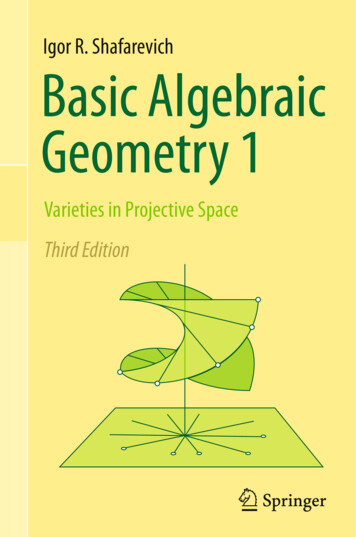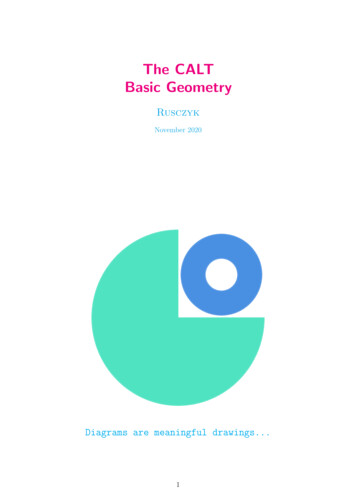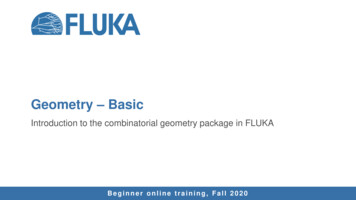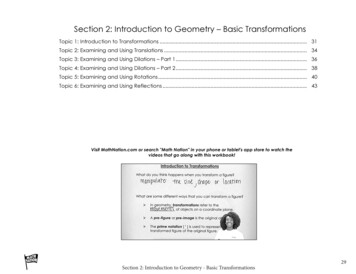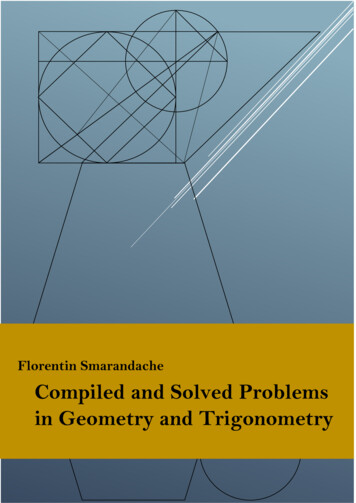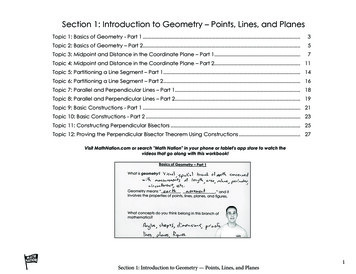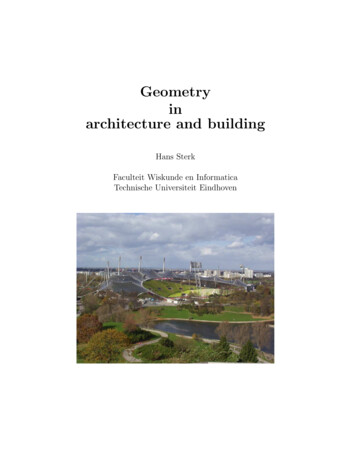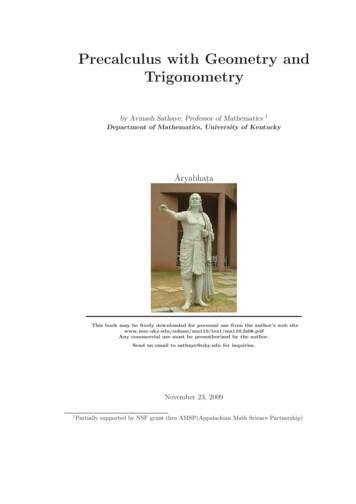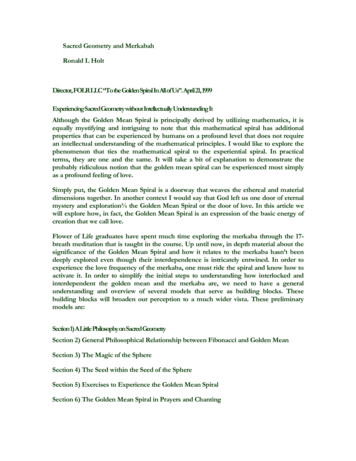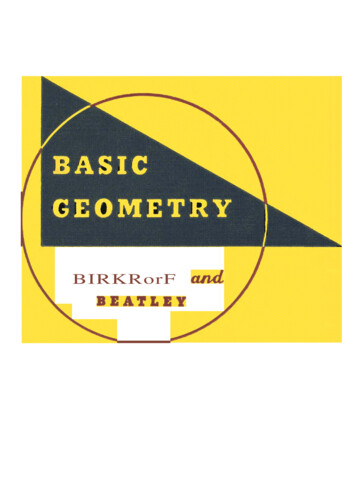
Transcription
BIRKRorFBBATLBYand
GEORGE DAVID BIRKHOFFProfessor of Mathematics in Harvard UniversityaM RALPH BEATLEYAssociate Professor of Education in Harvard UniversityTHIRD EDITIONCHELSEA PUBLISHING COMPANYNEW YORK
AcknowledgmentsThe authors express their appreciation of the helpful criticismthey have received from students in the Newton (Massachusetts)High School; from the teachers of these students, Mr. DonaldG. Enoch and Mr. Charles W. Peterson; and from Mr. CharlesH. Mergendahl, head of the department of mathematics. Theywish also to thank Mr. Paul E. Elicker, principal of the NewtonHigh School, for his courtesy in granting permission to use thisbook in experimental form.Acknowledgments for photographs are made as follows: AcmeNewspictures, page 132 (lower photograph); Art Institute ofChicago, page 132 (upper photograph); Ewing Galloway, page164, page 267 (upper right photograph); International HarvesterCompany, page 104 (upper photograph); International NewsPhotos, page 227 (lower left photograph), page 241 (photograph); Kenneth W. Moore, page 8 (lower photograph), page37 (two photographs), page 70 (two photographs), page 197;H. Armstrong Roberts, page 8 (upper photograph), page 227(lower right photograph); WaIt Sanders, from Black Star, page267 (upper left photograph); Underwood and Underwood, page267 (lower photograph); Wide World Photos, page 104 (lowerphotograph), page 227 (upper photograph). All diagrams anddrawings were made by Raymond E. Craig.COPYRIGHT 1940, 1941, BYSCOTT, FORESMAN AND COMPANYCOPYRIGHT 1959, BYSCOTT, FORESMAN AND COMPANYExperimental Edition. Geometr'll. Copyright. 1933, by the authorsPRINTED IN THE UNITED RTATES OF AMERICA
Pl'efaceThis textbook in geometry differs in several essential respectsfrom other current texts covering the same subject-matter.The nature of these differences is readily apparent to any experienced teacher who briefly scrutinizes the content of thebook. In this connection, however, a word of caution is inorder. Teachers of experience, from their very familiarity withother texts, may tend at first sight to be misled by the noveltyof this presentation and may see in it a difficulty which is apparent rather than real. They should be quick to realize, however,that their students-unhampered by experience-will not beso bothered. Actual classroom experience with an experimentaledition of these materials over a period of several years has conclusively demonstrated their teachability. From these materialsstudents acquire a mastery of geometry that is noticeablysuperior to the mastery gained from the traditional handlingof the subject. Moreover, students trained according to theprinciples of this book need have no fear of college entranceexaminations in geometry.The traditional approach to demonstrative geometry involves careful study of certain theorems which the beginneris eager to accept without proof and which he might properlybe led to take for granted as assumptions or postulates. Suchan approach obscures at the very outset the meaning of "proof"and "demonstration." The employment of superposition in theproof of some of these theorems is even more demoralizing.This method of proof is so out of harmony with the largeraim of geometry instruction that despite its validity its use iscommonly restricted to those few cases for which no bettermethod can be found. For fundamental postulates of our geometry, therefore, we have chosen certain propositions of suchbroad import that the method of superposition will not beneeded. We utilize only five fundamental postulates. Theyare stated and discussed in Chapter 2.For a rigorous mathematical presentation of the postulateswhich we have employed, see the article "A Set of Postulatesfor Plane Geometry, Based on Scale and Protractor" published3
in the Annals of Mathematics, Vol. XXXIII, April, 1932.Naturally it has been advisable in an elementary course toslur over or ignore some of the subtler mathematical details,for these are not suitable material for the mind of the studentat this juncture. Nevertheless, wherever the presentationinvolves a substantial incompleteness, its nature is indicated sofar as possible in an accompanying footnote.Another bugbear to beginners in geometry is "the incommensurable case." Euclid could not ignore the diagonal of theunit square and other similar lines, though he had no numberswith which to designate their lengths. By means of inequalities and an exceedingly shrewd definition of proportion he wasable, however, to handle these incommensurable cases. Withinthe last century this treatment of incommensurables-or anequivalent statement-has been taken as the definition of irrational numbers in general. Hence our geometry accepts thefundamental properties of real numbers, including the irrationals, and so avoids explicit mention of the incommensurablecase. For the teacher's convenience we present a brief discussion of the fundamental properties of the system of real numbers in the section Laws of Number, pages 284-288.Taking for granted these fundamental properties of number also leads to many other simplifications and gives us atool of the greatest power and significance. Among otherthings it enables us to combine the ideas "equal triangles" and"similar triangles" in general statements in which equality isbut a special case of similarity, where the factor of proportionality is 1. And, further, we can base the treatment ofparallels on similarity. This procedure, although the reverseof Euclid's, is logically equivalent to it. Thus our geometry,though differing in many important respects from Euclid's, isstill Euclidean; the differences reflect the progress of mathematics since Euclid's time.These changes are all by way of simplification and condensation. As a result, we have a two-dimensional geometrybuilt on only five fundamental postulates, seven basic theorems, and nineteen other theorems, together with seven on loci.The increase of knowledge and the growing demands of civilization make it more important than ever before that our instruction be as compact and profitable for the student as possible.Incorporation of the system of real numbers in three of thefive fundamental assumptions of this geometry gives these as-4
swnptions great breadth and power. They lead us at once tothe heart of geometry. That is why a geometry that is builton so strong a base is so simple and compact. It is becauseof the underlying power, simplicity, and compactness of thisgeometry that we call it basic geometry.In a course in demonstrative geometry our prime concern isto make the student articulate about the sort of thing thathitherto he has been doing quite unconsciously. We wish tomake him critical of his own, and others', reasoning. Thenwe would have him turn this training to account in situationsquite apart from geometry. We want him to see the need forassumptions, definitions, and undefined terms behind everybody of logic; to distinguish between good and bad arguments;to see and state relations correctly and draw proper conclusionsfrom them. To this end we have inserted analyses or summaries of the reasoning employed in the proofs of nearly allthe propositions and have included in Chapters 1 and 10 adetailed consideration of logical reasoning in fields outside ofgeometry.This book is designed to require one year of study, althoughit may readily be spread over two years in schools followingthat plan. Essentially it is a course in plane geometry. Realizing, however, that most students will give not more than oneyear to the study of geometry, we have incorporated certainmaterial from three-dimensional geometry and from modemgeometry (so called), so that for all classes of students thisfirst year of geometry may be as rich and enduring an experienceas possible. The three-dimensional material is based on thestudent's intuition and is not intended to be logically complete.The exercises are important for their content and for thedevelopment of the subject. None should be omitted withoutcareful consideration. Those marked with a star are of especial importance.The basic theorems 6,7,8, 11, and 13 can be deduced fromthe fundamental assumptions; but they will probably appear tothe student to be sufficiently obvious without proof. It willbe wise, therefore, to permit the student to assume thesetheorems at the outset. He should return to them later, whenhe has caught the spirit of the subject more fully and can beinterested in the problem of reducing his list of assumptionsto a minimum. This comes about naturally in Chapter 10,where the assumptions are reconsidered.5
The brief treatment of networks and the slope and equationof a line in Chapter 4, together with the related exercises, and thebrief treatment of the equation of a circle in Chapter 5 areincluded to show the relation of this geometry to analyticgeometry. They may be omitted without injury to the logicaldevelopment of the subject. The teacher may wish to deallightly with continuous variation in Chapter 8 and to omit inChapter 9 the sections devoted to power of a point, radical axis,inversion, and projection.In every class in geometry it is excellent procedure to elicitsuggestions from the students as to theorems worth provingand the best way of proving them. Unfortunately, however,theorems cannot always be proved in the order proposed bythe students; or they can be proved in the suggested order onlyif certain other intermediary theorems are interpolated at theright places. Correct decisions on questions of this sort sometimes require complete grasp of the entire logical frameworkof the geometry. In order to avoid confusion, therefore, theauthors have chosen the order of the theorems in the severalexercises; they wish, nevertheless, to approve every well-considered effort on the part of teachers to elicit the cooperationof students in building the geometry. It is not impossible thata faulty procedure suggested by the students will have moreeducative value than a correct procedure imposed by authoror teacher. This is most likely to be true when the teacherpoints out to the students wherein their procedure is wrong.The value of demonstrative geometry as prevailingly taughtin secondary schools is being questioned, and not withoutcause. It would be difficult to prove that the study of thesubject necessarily leads in any large measure to those habits,attitudes, and appreciations which its proponents so eagerlyclaim for it. But it would be even more difficult to prove thatother subjects of instruction can yield these outcomes as easilyand as surely as can demonstrative geometry in the hands ofan able and purposeful teacher. Teachers of demonstrativegeometry are confronted with the challenge to re-shape theirinstruction so that it more nearly achieves the desired objectives.This textbook is offered as an instrument to that end.GEORGE DAVID BIRKHOFFRALPH BEATLEY6
ContentsPAGECHAPTER1.REASONING.2.THE FIVE FUNDAMENTAL PRINCIPLES383.THE SEVEN BASIC THEOREMS714.PARALLEL LINES AND NETWORKS1055.THE CIRCLE AND REGULAR POLYGONS1336.CONSTRUCTIONS WITH STRAIGHTEDGE AND COMPASSES.1657.AREA AND LENGTH.1988.CONTINUOUS VARIATION2289.LOCI . . .24210.REASONING.THE NATURE OF PROOF.ABSTRACT LOGICAL SYSTEMS9268LAWS OF NUMBER284INDEX . . . . .2897
CHAPTER 1Reasoning. The Natul'e of Pl'oofCONSIDERthe following two disputes, just asif you had been asked to decide them.Dispute 1. The upper picture on the opposite pageshows the Mohawks and the Wildcats playing baseball.At the end of the fourth inning the score stands: Mohawks,6; Wildcats, 7. Luke Tobin is pitching for the Mohawks.His older brother John considers himself to be aboutas good a pitcher as Luke, but the rest of the Mohawksthink that Luke is a much better pitcher than John.They admit, however, that except for Luke they haveno one who can pitch as well as John. John hits wellbut is not good at fielding batted balls. The rest of theteam think he belongs out in left field, and that is wherehe is playing in this game against the Wildcats.The two teams have only two bats, one belonging toLuke and the other to John. In the first half of the fifthinning, with two men out, the Mohawks get another run,tying the score. Then John hits a home run, puttingthe Mohawks ahead. The next batter hits a foul and inso doing breaks Luke's bat. Immediately John seizeshis own bat and announces to his teammates that if theydon't let him pitch the second half of the fifth inning andall the rest of the game, he will take his bat and go home.9
The Mohawks greet this announcement with boos andjeers, but John sticks to his point and is perfectly willingto break up the game if he cannot have his way. He isbig enough to get away with it, too, especially since hehas possession of the bat.Hank Cummings, shortstop and captain of the Mohawks,suggests that Luke and John swap positions, but thatJohn agree to return to left field and let Luke pitch in casethe Wildcats tie the score. The rest of the Mohawksthink that their lead of one run is none too secure withLuke pitching, and that to let John pitch is practically togive the game to the Wildcats, even if John agrees toHank's proposal. They declare that they would ratherquit playing then, and there than continue under such anagreement.The Wildcats join the hubbub at this point and offer topunch a few faces if they don't get their turn at bat inthe second half of the fifth. They announce that if thegame breaks up, they will have won with a score of 7-6;that the Mohawk runs in the first half of the fifth don'tcount unless the Wildcats have their chance at bat in thesecond half of the inning.Remember that John has just scored the run puttingthe Mohawks ahead and that he feels confident he canhit anything the Wildcat pitcher can offer. Rememberalso that the Mohawks usually depend upon Luke andJohn to supply not only the bats but also the ball whenever they play. Remember finally that they never letJohn pitch in any
the heart of geometry. That is why a geometry that is built on so strong a base is so simple and compact. Itis because of the underlying power, simplicity, and
